By: Henri Matisse
Week: 1
In 'Woman with a Hat,' Henri Matisse painted his wife, Amelie. Amelie wears a brightly colored hat and dress, but her mouth is downturned. She holds a small fan in her gloved hand. This painting is an example of Fauvism, a style that incorporates vivid, unnatural colors. Examine the painting to see how Matisse shaded Amelie's face with brushstrokes of turquoise.
By: Henri Matisse
Week: 2
Painted in a modernist, Fauvist style, Henri Matisse's 'The Open Window' features a view from a window. The shutters have been thrown open to reveal a surreal view of sailboats bobbing on a gentle sea. Potted flowers and creeping vines adorn the outside of the house. The sky is in shades of white, purple, and pink, and the sea is mostly white and pink. The walls inside the house are painted in vivid colors.
By: Henri Matisse
Week: 3
The surreal colors of Henri Matisse's 'The View of Collioure' reveals the landscape as another example of Fauvism. Tucked in among the mountains, Collioure is a seaside fishing village in southern France. Matisse captures the small village, the sea, the mountains, and the sky using broad brushstrokes of vivid color.
By: Henri Matisse
Week: 4
Henri Matisse's 'The Dessert: Harmony in Red (The Red Room)' painting was influenced by Japanese art and features the color red. Matisse first painted the work in blue, but was unsatisfied with the outcome and repainted it red. 'The Red Room' shows a woman tending a table covered in a red cloth and laden with fruit and wine. A view through the window shows a blue sky, a green lawn, bushes, white trees, flowering plants, and a pink building. Some experts consider this painting Matisse's masterpiece.
By: Henri Matisse
Week: 5
In Henri Matisse's 'Woman in a Purple Coat,' Lydia Délectorskaya, Russian refugee and studio assistant to Matisse, lounges on a chair draped in a striped purple coat. The style of her clothing is Moroccan (a country in northern Africa). The floral painted table in the work holds fruits and a vase of blooming yellow flowers. A magazine lies at her feet. Other than the fruit, most objects in the painting are outlined with thick black lines.
By: Georgia O'Keeffe
Week: 6
In 'Blue and Green Music,' Georgia O'Keeffe attempts to paint the sound of music in visual color. The undulating lines represent waves of sound.
By: Georgia O'Keeffe
Week: 7
Georgia O'Keeffe's 'Apple Family II' is a still life depicting a variety of apples on a white cloth background.
By: Georgia O'Keeffe
Week: 8
Georgia O'Keeffe spent several years at Lake George, a lake in upstate New York. In O'Keeffe's landscape, 'Lake George,' she captures the gentle peaks of the Adirondacks and their reflection in the waters of Lake George.
By: Georgia O'Keeffe
Week: 9
In Georgia O'Keeffe's landscape, 'My Shanty Lake George,' she portrays, 'the shanty,' an old barn that served as her art studio during her time at Lake George, a lake in upstate New York. This work features strong lines and shapes in a Precisionist style. Precisionists painted street, factory, or farm landscapes without people in them. Note the wildflowers, the trees, the dark mountains rising in background, and they grey clouds hovering overhead.
By: Georgia O'Keeffe
Week: 10
In Georgia O'Keeffe's 'Maple and Cedar, Lake George,' she focuses on the vibrant reds, oranges, and greens of the trees in fall at Lake George, a lake in upstate New York.
By: Norman Rockwell
Week: 11
Norman Rockwell's 'Boy with a Baby Carriage' was his very first Saturday Evening Post cover, and it was a hit. The picture shows an unhappy boy dressed up in a suit and black hat and pushing a carriage. The strap of his hat flies through the air, hinting that he is walking fast. A baby bottle of milk sticks out from his pocket. A tiny red shoe is visible in the carriage. Why is the boy so unhappy? Two smirking boys in baseball uniforms are passing by and teasing him. One tips his hat, and the other places a finger to his chin. The uniformed boys are off to have fun playing baseball, while the boy in the suit must take care of his little brother or sister.
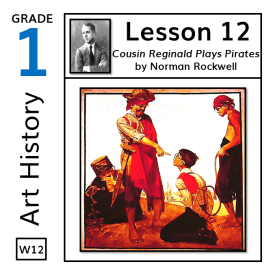
By: Norman Rockwell
Week: 12
Cousin Reginald is a bespectacled city boy featured in many of Norman Rockwell's paintings. Reginald travels to visit his mischievous cousins in the country to become the 'fish out of water.' In Norman Rockwell's 'Cousin Reginald Plays Pirates,' poor Reginald has been captured and bound by his wild pirate cousins. The main pirate jabs a finger in poor Reginald's face while wearing a black hat, red scarves, and a wooden sword. The seated boy wears a metal pot scrawled with 'Captain Kidd' and a Jolly Roger flag. The bare-chested third boy holds Reginald's rope leash and scowls. He has a black moustache and beard painted on his face. In the background, a dog rides on a small raft.
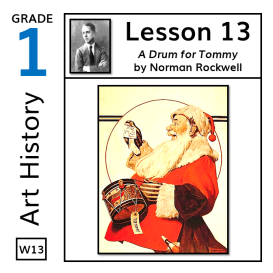
By: Norman Rockwell
Week: 13
Norman Rockwell's 'A Drum for Tommy' shows a rosy faced, white bearded Santa Claus wearing a sprig of holly behind his ear and holding a drum with a tag reading 'Tommy.' Santa also holds his black bag of toys from which a rocket ship is visible. One hand raises a note and a small stocking. The misspelled note reads, 'PLESE GIVE ME A DRUM TOMMY.'
By: Norman Rockwell
Week: 14
In Norman Rockwell's 'The Circus Barker,' two boys dress up and play circus. One wears a jersey and long underwear and flexes his artificially bulked up muscles as, SANDOW, the show's strongman. 'Sandow' wears a red headband with a feather, has symbols painted on his face, and fake wire hoop earrings. The other wears an oversized top hat and someone's father's suit and has painted a black moustache on his upper lip. A group of children cluster around to see the show.
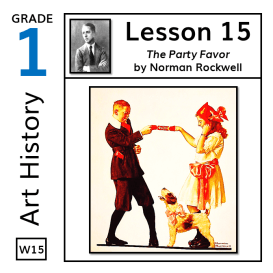
By: Norman Rockwell
Week: 15
In Norman Rockwell's 'The Party Favor,' a girl and a boy dressed in party clothes tug on the ends of a noisemaker. They wince in anticipation of the 'pop.' The dog, dressed in big pink bow, looks on with excitement. The boy has a second noisemaker in his pocket. Which holiday are they children celebrating? Is it a birthday party? It is most likely Independence Day, also known as the Fourth of July. The girl wears an old-fashioned military hat, and the noisemaker is decorated with the Union Jack, the United Kingdom flag.
By: Ivan Aivazovsky
Week: 16
Ivan Aivazovsky's 'Battle of Çeşme at Night,' shows the naval conflict between the Russian and Ottoman fleets at the harbor of Çeşme. The Russians defeated the Ottomans. Çeşme is located on the Aegean Sea. The Aegean Sea is bordered by Greece, Turkey, and the Mediterranean Sea.
By: Ivan Aivazovsky
Week: 17
Ivan Aivazovsky's 'Battle of Navarino' depicts a battle in the Bay of Navarin between British-French-Russian naval forces and an Egyptian-Turkish fleet. The British-French-Russian fleet trounced its opposition. This battle helped Greece gain independence from Turkey.
By: Ivan Aivazovsky
Week: 18
Ivan Aivazovsky's 'Azure Grotto, Naples,' shows 'The Blue Grotto,' a sea cave off an island in southern Italy. Due to interactions between light and water, only blue light enters the cave and items submerged in the grotto's waters look silver.
By: Ivan Aivazovsky
Week: 19
Ivan Aivazovsky's 'Meeting of the Brig Mercury with the Russian Squadron After the Defeat of Two Turkish Battleships,' shows a naval vessel sailing on a calm sea in the moonlight. The Mercury is worse for the wear, several holes are visible in her sails. On the horizon, the rest of the Russian fleet awaits. Note how Aivazovsky captured the translucent glow of the waves under the moonlight. The Mercury was a real ship, a 20-gun brig, that fought many battles in its time.
By: Ivan Aivazovsky
Week: 20
Ivan Aivazovsky's 'Ship Twelve Apostles' features a battle ship called the 'Twelve Apostles.' The 120-cannon Russian battle ship was one of the finest and fastest vessels of its time. In the painting, the ship Twelve Apostles cuts through a choppy sea, its flags billowing in the wind and another ship following in its wake.
By: Edward Burne-Jones
Week: 21
Edward Burne-Jones' 'Cinderella' shows Cinderella in front of an endless wall of blue china wearing drab, patched clothing. It is after the ball, for Cinderella wears a single glass slipper. Now she has returned to the drudgery and loneliness of her regular life. She looks thoughtful and a little sad, perhaps thinking about her magical night with the prince. One hand holds out her apron, like she might a long dress while dancing.
By: Edward Burne-Jones
Week: 22
Edward Burne-Jones' 'The Rose Bower' shows Sleeping Beauty and her attendants, all enchanted into a deep sleep. Inspired by the Jacob and Wilhelm Grimm Fairy Tale, 'Little Briar-Rose,' this painting is part of a series called 'The Legend of Briar Rose.'
By: Edward Burne-Jones
Week: 23
Edward Burne-Jones' 'The Briar Wood' shows soldiers, who were long ago cast into an enchanted sleep, tangled within the thorny clutches of the briar rose. A knight has discovered them while on a quest to rescue Sleeping Beauty and her kingdom. He must brave the thicket of barbed vines to reach the castle, where perhaps he can wake the Sleeping Beauty with a kiss. Inspired by the Jacob and Wilhelm Grimm Fairy Tale, 'Little Briar-Rose,' this painting is part of a series called 'The Legend of Briar Rose.'
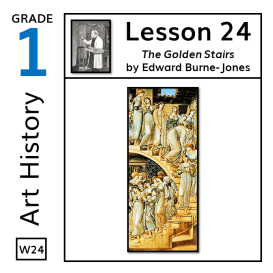
By: Edward Burne-Jones
Week: 24
In Edward Burne-Jones' 'The Golden Stairs,' a line of young women holding musical instruments curves down an elegant staircase. Some women wear wreaths of leaves in their hair. Some women chat as they descend. We don't know why the women are there, what they are doing, or why they all hold instruments. Some of the women painted are based on real people. For instance, Burne-Jones' daughter, Margaret, holds a spindly trumpet and stands fourth from the top of the staircase.
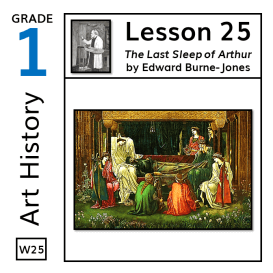
By: Edward Burne-Jones
Week: 25
In Arthurian legend, the great King Arthur never died. Instead, he remained in a deep slumber until his nation needed him most. Edward Burne-Jones' 'The Last Sleep of Arthur in Avalon' shows a mortally wounded King Arthur lying under a canopy on a bench in Avalon. Mourning women in flowing robes surround him. Some women play instruments such as dulcimers and a harp. Queen Morgan le Fay, King Arthur's sister, gently cradles his head upon her lap. While painting 'The Last Sleep of Arthur in Avalon,' Burne-Jones became so obsessed with his work he called himself Arthur and slept in the same pose as Arthur in the painting. Burne-Jones worked on the painting during the last years of his own life. He died before he could finish the painting. Look closely, and you'll see that some of the instruments have no strings. The painting is enormous, measuring over nine feet high and 21 feet long. The image below is only the central portion of the full painting.
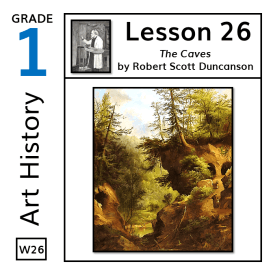
By: Robert Scott Duncanson
Week: 26
Robert Scott Duncanson's landscape, 'The Caves,' captures the natural beauty of caves in Ohio. On first gaze, the viewer may not spot any humans in the painting. Do you see the people? How many do you see? Do you see the man helping the lady up the incline to the cave openings on the right? Do you see the lady up above them? Do you see any other people? Look closer, and you will see two people fishing on the riverbank in the background. Would you go inside the caves?
By: Robert Scott Duncanson
Week: 27
Robert Scott Duncanson's 'Woodland Stream' shows a peaceful sylvan landscape showcasing calm waters flowing under a greenery-draped bridge. Small white flowers adorn a cluster of vegetation on the right bank. A person in red, perhaps a young boy, sits on a rock and enjoys the renewing solitude the scene offers.
By: Robert Scott Duncanson
Week: 28
In his world travels, Robert Scott Duncanson spent considerable time in Italy. In Duncanson's 'Pompeii' he paints from imagination the first excavation of the site, which occurred in 1747. Men wearing 1700s garb, gesture toward one of the treasures they have uncovered from the ancient Roman ruins of the city of Pompeii, an intact painting. In the background, sailboats sail the peaceful lake and the volcano, Mount Vesuvius, expels a cloud of smoke.
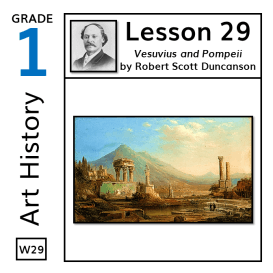
By: Robert Scott Duncanson
Week: 29
Also inspired by his travels to Italy, Robert Scott Duncanson's 'Vesuvius and Pompeii' pairs the smoking volcano, Mount Vesuvius, with various Roman ruins including the ancient Roman city of Pompeii. On the right, two men in suits engage in discussion. One of the men sits on the crumbling steps of an ancient amphitheater. In the center, between two bodies of water, three people enjoy the view. Ribbed pillars jut into the sky, one still topped by an ancient sculpture. A painting that once adorned a wall still stands, retaining its color in defiance of time and weather.
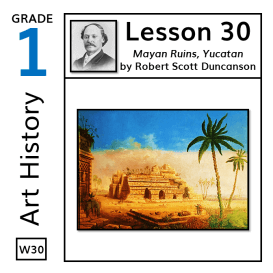
By: Robert Scott Duncanson
Week: 30
Inspired by exotic engravings in a book about adventures in the Yucatán, Robert Scott Duncan painted an imaginary view of Mayan ruins. The Yucatán is a state of Mexico famous for its beautiful beaches and Mayan ruins. The Maya was a civilization originating in the Yucatán thousands of years ago (2600 B.C.). The Maya people still inhabit Mexico and Central America today.
By: Natalia Goncharova
Week: 31
In Natalia Goncharova's vividly colored 'Archangel Michael,' the Archangel St. Michael rides a winged Pegasus under a bright star. He holds a Bible and scales in one hand blows a trumpet using the other. Some believe St. Michael will call all people to be judged for the Biblical Last Judgment. He will then weigh their souls on his scales to determine who goes to heaven and who goes to hell.
By: Natalia Goncharova
Week: 32
Natalia Goncharova's 'Sheep Shearing' shows peasant women in traditional headscarves and dresses using scissors to cut the wool off sheep. A girl looks on with a sad look as she cradles a lamb. In the background, a woman pulls a young child in a wagon in front of a line of trees and bushes. Simple huts and fences also adorn the background.
By: Natalia Goncharova
Week: 33
Natalia Goncharova's 'Espagnole' (Costume Espagnole) sold for 10.7 million dollars at auction, one of the highest prices for a female artist ever. It features the costume design for a Spanish dancer. This work formed part of 'L'Art Décoratif Théâtral Moderne,' a collaborative collection betweeen Goncharova and her lifelong significant other, Mikhail Larionov.
By: Natalia Goncharova
Week: 34
Natalia Goncharova's 'The Cyclist' is an example of Futurism, an art form that features topics such as youth, industrialism, technology, and transportation.
By: Natalia Goncharova
Week: 35
Natalia Goncharova's 'Women with Rakes' shows peasant women in traditional headscarves and dresses. They carry rakes over their shoulders as they walk to or from work.
By: Natalia Goncharova
Week: 36
Natalia Goncharova's 'Cats' is an example of 'Rayonism,' which sought to show objects not as they appeared, but as the rays of light reflecting off the objects. Look at the painting. Do you see the actual cat - the eyes, whiskers, or nose? Look at the painting again. Does the painting suggest a cat, or does it prompt your imagination to picture a cat? Perhaps the lines cutting across the canvas remind you of a cat slashing with its claws. Perhaps the triangles remind you of the shapes of the face or ears of a cat.